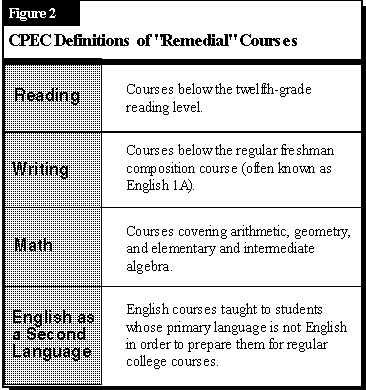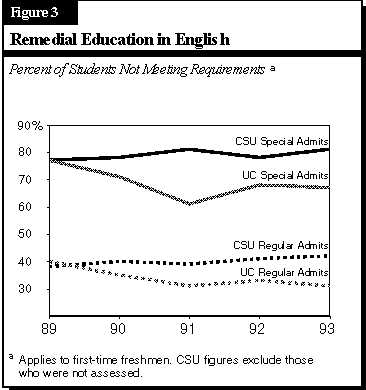

A recent report indicated that over 40 percent of new California State University (CSU) freshmen needed assistance ("remedial education") in English and/or math before they could attain success in college-level English and math courses. The CSU Trustees plan to consider changes in the CSU policy on remedial education at their January 1996 meeting. Below, we provide information on adult remedial education in California. Figure 1 summarizes our major findings.

Remedial education is offered by the University of California (UC), the CSU, the California Community Colleges (CCC), and by school districts through K-12 adult education courses. It appears that the CCC and K-12 adult education programs often cover more basic course work than UC and CSU remedial education courses.
At the CSU, new freshmen and transfer students must demonstrate competence in English reading and writing and in math by taking the English Placement Test (EPT) and the Entry Level Mathematics (ELM) test, unless they achieve certain scores on other specific exams or successfully pass an acceptable college course. The EPT consists of one hour of reading and composition questions and a 45-minute essay. The ELM consists of
75 minutes of multiple-choice questions covering elementary and intermediate algebra and geometry.
School districts and community colleges generally make the determination of whether students need remedial education at the local level. In other words, no statewide exams are given.
Assessment Results at UC and CSU. Figure 3 shows the percentage of first-time freshmen at UC and CSU, by admission status, who did not meet the English requirements since 1989 (the earliest year consistent data are available). Regularly admitted freshmen have taken required high school courses and have achieved specified grade point averages and test scores. Specially admitted students--up to 6 percent of new students at UC and up to 8 percent at CSU--have not met one or more of these requirements, but generally have demonstrated the ability to succeed in college.

About 34 percent of total UC entering freshmen and about 49 percent of total CSU entering freshmen tested need remedial English instruction. As the figure indicates, a substantial proportion of regular admits and twice those proprtions of special admits at both segments fail to meet the English requirements. The figure also indicates that the percentage of first-time freshmen at UC that do not meet the English requirement has declined significantly since fall 1989, while the percentage at CSU has increased slightly. The CSU indicates that the increasing proportion of high school graduates entering CSU for whom English is not their first language may help explain the increase.
University of California. Of the 19,445 freshmen (both regular and special admits) enrolling at UC in fall 1993, 6,514 (34 percent) did not meet the Subject A requirement and were required to take an appropriate writing course. Systemwide enrollment information in remedial math is not available. We estimate that the annual cost for all types of remedial education at UC is likely to be in the range of several million dollars.
California State University. Of the 57,742 new freshmen and transfer students (both regular and special admits) enrolling at CSU in fall 1993 who were tested, 10,483 (18 percent) did not meet the English requirement and 12,173 (21 percent) did not meet the math requirement and were referred to remedial courses. (The overall proportion of new CSU students who did not meet the English requirement is lower than the proportion shown in Figure 3 because almost all transfer students meet the requirement.) The CSU indicates that the annual cost for remedial education is $9.3 million.
California Community Colleges. About 121,000 full-time-equivalent students [FTES] were enrolled in remedial education courses at the CCCs in Fall 1993. This was about 14 percent of total FTES. The number of individual students represented by this figure is unknown, because of the way the Chancellor's Office reports CCC enrollment. Remedial instruction at the CCCs includes English as a Second Language (ESL) and basic reading, writing, and computational skills, as well as precollegiate instruction.
It is not possible given existing data to determine conclusively how remedial education enrollment has varied in recent years. It appears, however, that remedial education enrollment may have declined, even though ESL enrollment increased by about 3,500 FTES, or 12 percent, from fall 1992 to fall 1993. We estimate that the cost of remedial education at the CCCs in 1993-94 was about $365 million.
K-12 Adult Education. We estimate that almost 700,000 individual students were enrolled in remedial education through school district adult education courses in fall 1993. About two-thirds of these students were enrolled in ESL courses, while the remainder were enrolled in other basic education courses. We estimate that the state cost of these remedial education courses was about $240 million in 1993-94.
Contact--Donna Watins Olsson--(916) 445-8641
General Fund revenues in October exceeded the budget estimate by $143 million, reflecting gains from each of the major taxes (personal income, sales, and bank and corporation). For the first four months of the fiscal year, cumulative receipts are up $676 million (5.3 percent), of which about $500 million appears to be permanent. The revenue gains are consistent with the recently stronger-than-expected performance of California's economy.
A more detailed discussion of the current economic and revenue outlook is contained in California's Fiscal Outlook: The LAO's Economic and Budget Projections, 1995-96 Through 1997-98 (released November 16, 1995).
Contact--Brad Williams--(916) 324-4942